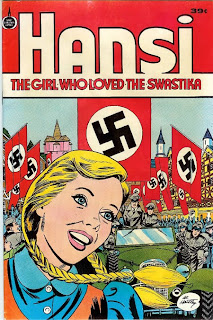This is the ongoing story of recapturing that feeling by reading unread comics. Perhaps they live in some long-neglected long box in the spare room. Maybe they are discovered at the bottom of that last box unpacked since that last move two years ago, and perhaps they're just waiting in some comic shop's back stock waiting for someone to discover them the next time they're dragged to some mini-convention in a hotel ballroom looking to score some quick cash with cheap back issues. Sometimes they'll be gems, and sometimes the memory is fonder than the reality, but the goal is to share spoiler-ridden Reviews Of Old Comics.

She-Hulk got her own title again in 1989, done by John Byrne, the writer/artist that brought new life to her character in Fantastic Four. Within a year, however, Byrne had left the book in a dispute over his artwork being redrawn. Story quality suffered until he was brought back to continue her adventures in the same vein he used when he started the book. Namely, She-Hulk knew she was in a comic book, faced heroes and villains largely forgotten because "serious" writers thought they were too stupid to be resurrected, and never took any of it too seriously.
 Sensational She-Hulk #31
Sensational She-Hulk #31
September 1991 - Marvel Comics
Writer/Penciller: John Byrne
Inker: Keith Williams
Color: Glynis Oliver
Letterer: Jim Novak
SYNOPSIS:
She-Hulk wakes up from the bad dream of issues 9-30 and, realizing how late it is by reading the legal text at the bottom of the first page, rushes to get ready, with a convenient white box provided by Byrne to keep the book approved by the Comics Code. She also asks him to give her the "fake McFarlane layouts" he's using in Namor and flies off to pick up Louise Mason in her flying green car for a trip to sunny Florida.
Meanwhile, a jet transporting a disgraced rock star is caught in a bad storm and tries to avoid crashing into a mountain but fails when it seems that the mountain moves to intercept them. She-Hulk and Louise hear the report and detour to investigate the mysterious moving mountain, which has vanished from the crash site. A scientist on the scene named Bob Robertson claims that it was the work of Spragg, the Living Hill.
He relates how he came across Spragg many years ago in Transylvania after he had enslaved a small village to build a machine to increase his mental powers. Spragg was an evil member of a race of alien spores that had become trapped in the forming Earth and developed the psychic abilities they used to create earthquakes. Bob Robertson was immune to Spragg's powers because of the mining helmet he was wearing and turned the machine into a rocket which sent Spragg into space. He discovered that Spragg had vaporized upon reentry into the atmosphere and became a force responsible for unexplained natural disasters.
Using a small device, Bob Robertson triggers the Spragg effect, inadvertently causing a ridge of rock to endanger a nearby town. She-Hulk drops from her flying car onto the front of the moving outcrop and places a device to stop it in its tracks. However, the sudden stop sends her plummeting into a hole in the Earth that opened up where the front of the ridge had been.
REVIEW:
There was a time when comic publishers could put out a tongue-in-cheek book. This is just after Giffen and DeMatteis's Justice League International, which returned humorous comics to the mainstream. John Byrne had fun with the tropes of the comic book medium and the superhero genre in general. In this issue alone, he pokes fun at the all-encompassing aptitude of comic-book scientists, such as an entomologist building robots, the ego of creators, and the ever-looming presence of the Comics Code Authority.
Byrne's art in this issue is probably at his peak, with very few blank backgrounds and a very believable rendering of a pre-Silver Age character like "The Living Hill." His Bob Robertson isn't as consistent as his She-Hulk or Louise Mason. Given the low number of characters with significant roles in this issue, it's not confusing. In his writing, he tends to be very verbose but doesn't fall into the trap of describing things that can be seen.
The story is a refreshing pallet cleanser after the grimmer fare of most modern comics, but a better switch between comedy and serious drama is needed. It actually detracts from a jet full of people being killed. Those distractions are probably more from Byrne's sense of storytelling, which is very fast, benefiting his art style of using large panels.
The colors, as appropriate to the time, are flat, which works very well with John Byrne's style. For an example of how bad modern colors can look on this art, just look at the cover of Sensational She-Hulk, Vol.1 collection, which collects the issues just before this one. Modern coloring over this would still need to retain the flatness to not take away from the visuals of She-Hulk among normal-sized people. I just don't see how it could improve very much to have heavily rendered colors on this artwork.
FINAL RATING: 8 (out of a possible 10)
NOTES:
This issue was collected in 2019's Sensational She-Hulk by John Byrne Omnibus. In back issue bins, you should be able to find copies at a very reasonable price, perhaps even a bargain. For immediate satisfaction, it's available digitally as part of Marvel Unlimited. The rest of Byrne's run is also there.





































